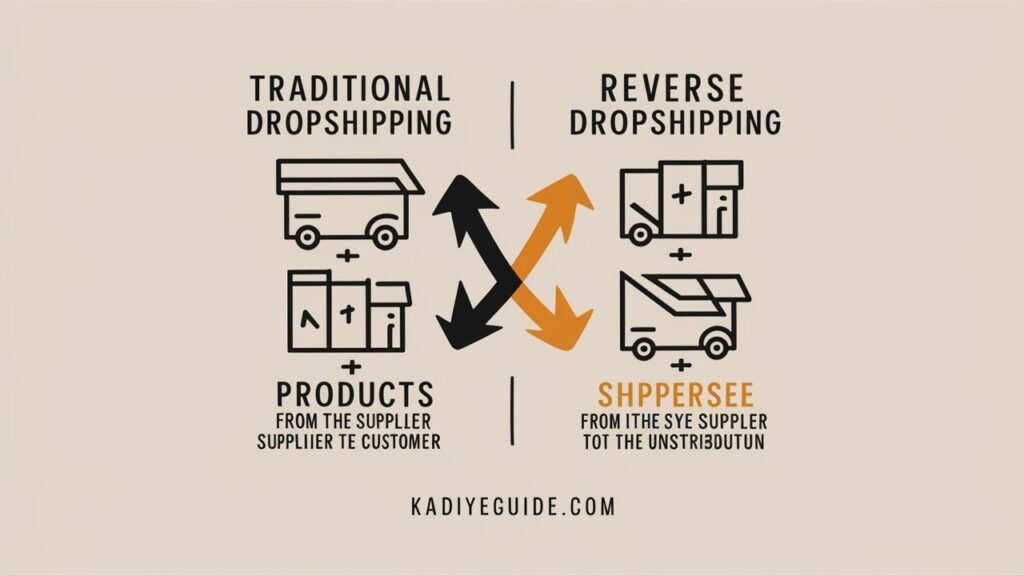Reverse dropshipping is an innovative e-commerce model that flips the traditional approach by sourcing high-quality products from developed countries and selling them to consumers in emerging markets. This strategy leverages the demand for premium goods in regions where such items are less accessible, offering unique opportunities and challenges for entrepreneurs.
Understanding Reverse Dropshipping
In traditional dropshipping, retailers typically source low-cost products from suppliers in countries like China and sell them to consumers in higher-income countries at a markup without ever handling the products directly. Reverse dropshipping, however, involves sourcing high-quality, premium products from developed countries and selling them to consumers in emerging markets where such goods are sought-after but scarce.

How Reverse Dropshipping Works
- Product Sourcing: Identify premium products from suppliers in developed countries, focusing on items that appeal to consumers in emerging markets.
- Market Research: Analyze target markets to understand consumer preferences, purchasing power, and demand for specific products.
- Platform Setup: Establish an online store or utilize existing e-commerce platforms to showcase and sell products to the target audience.
- Order Fulfillment: When an order is placed, purchase the product from the supplier, who then ships it directly to the customer, minimizing the need for inventory management.
Advantages of Reverse Dropshipping
- Higher Profit Margins: Since you deal with high-end products, the profit margin in reverse dropshipping is usually high.
- Reduced Competition: The uniqueness of the products can result in less market competition.
- Enhanced Brand Reputation: Offering high-quality products can improve brand image and customer trust.
Challenges in Reverse Dropshipping
- Complex Logistics: Managing international shipping and customs can be intricate and costly.
- Understanding Diverse Consumer Preferences: Adapting to the cultural and purchasing behaviors of consumers in emerging markets requires thorough research.
- Supplier Relationships: Ensuring consistent product quality and reliability necessitates strong partnerships with suppliers.

Case Studies
- Successful Implementation: Examples of businesses that have effectively utilized reverse dropshipping to penetrate new markets.
- Lessons Learned: Insights into overcoming common challenges and leveraging advantages.
Top Lucrative Product Categories in the Dropshipping Industry
In the dynamic world of dropshipping, certain product categories consistently stand out due to their high demand and profitability. Focusing on these trending products can provide dropshipping businesses with opportunities to meet consumer demand and achieve substantial sales. According to recent analyses, the following categories have been identified as particularly lucrative:
1. Health and Personal Care Products
Items such as electric toothbrushes, acne patches, and posture correctors have seen significant popularity. These products cater to consumers’ growing interest in personal well-being and health maintenance.
2. Baby Products
The baby care market is projected to grow substantially, with products like organic baby clothing, teething toys, and hypoallergenic wipes leading sales. This trend reflects parents’ increasing preference for high-quality and safe products for their children.
3. Pet Supplies
With the pet industry experiencing significant growth, items such as pet grooming tools, pet clothing, and interactive toys have become bestsellers. Pet owners are continually seeking products that enhance their pets’ well-being and happiness.
4. Kitchen and Dining Accessories
Products like stainless steel tumblers, digital kitchen scales, and vegetable choppers are in high demand. These items appeal to consumers looking to enhance their culinary experiences with functional and stylish tools.
5. Home Fitness Equipment
The rise in home-based workouts has led to increased sales of items like yoga mats, resistance bands, and portable blenders. These products support consumers’ efforts to maintain fitness routines outside traditional gym settings.
Focusing on these trending products can provide dropshipping businesses with opportunities to meet consumer demand and achieve substantial sales.
Reverse dropshipping is a retail fulfillment method where businesses source high-quality products from developed countries and sell them to consumers in emerging markets. This approach contrasts with traditional dropshipping, which typically involves sourcing low-cost products from countries like China to sell in higher-income markets. By targeting regions where premium goods are less accessible, reverse dropshipping caters to the growing demand for quality products among consumers in developing countries.
Conclusion
Reverse dropshipping presents a unique opportunity for entrepreneurs to tap into emerging markets by offering high-quality products from developed countries. While the model boasts advantages like higher profit margins and reduced competition, it also comes with challenges such as complex logistics and understanding diverse consumer preferences. Careful planning, thorough market research, and strong supplier relationships are crucial for success in this innovative e-commerce approach.
Interested in exploring the potential of reverse dropshipping for your business? Contact us today to learn how you can tap into emerging markets with high-quality products and elevate your e-commerce strategy.
FAQs
- What is reverse dropshipping?
Reverse dropshipping involves sourcing high-quality products from developed countries and selling them to consumers in emerging markets.
- How does reverse dropshipping differ from traditional dropshipping?
Traditional dropshipping typically involves sourcing low-cost products from countries like China to sell in developed markets, whereas reverse dropshipping sources premium products from developed countries to sell in emerging markets.
- What are the benefits of reverse dropshipping?
Benefits include higher profit margins, reduced competition, and enhanced brand reputation.
- What challenges are associated with reverse dropshipping?
Challenges include managing complex logistics, understanding diverse consumer preferences, and maintaining strong supplier relationships.
RELATED ARTICLE
Understanding High-Ticket Dropshipping: A Comprehensive Overview
Exploring Profitable Eco-Friendly Dropshipping Niches for 2024
Shopify Store Secrets: How to Boost Sales and Grow Your Online Business
Game-Changing E-commerce Platforms: How to Skyrocket Your Online Sales
Rakuten Exposed: What It Is, How It Works, and Whether It’s Truly Worth Using
How to Save Money Fast: 7 Proven Tips for Beginners
How Much Should You Save? Building the Perfect Balance Between Emergency Fund and Savings
Private Label Dropshipping Suppliers: How to Build a Profitable Brand in 2025
The Ultimate Guide to Budget Tracker Apps for Beginners: Tips and Trick



